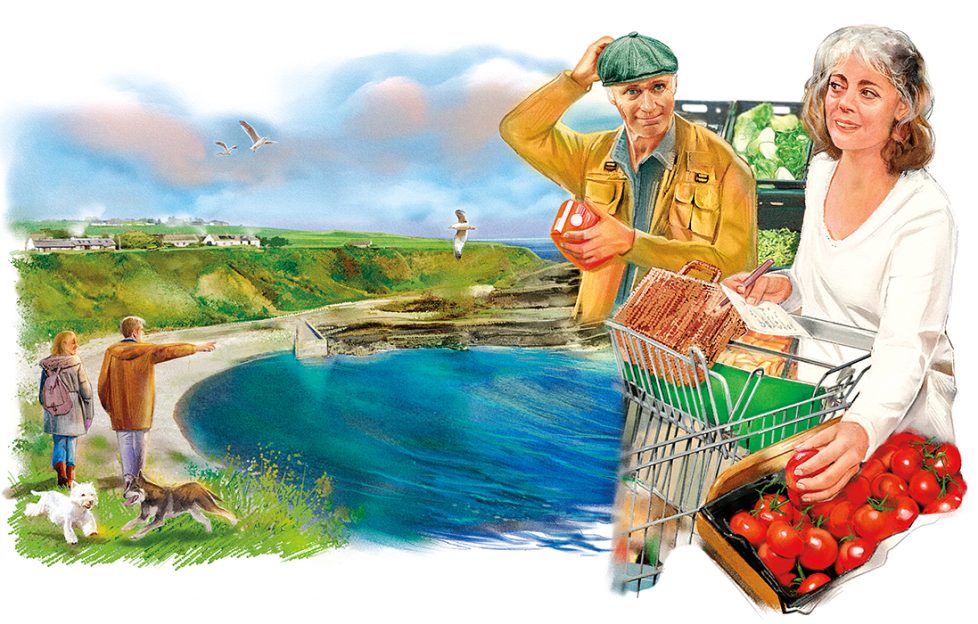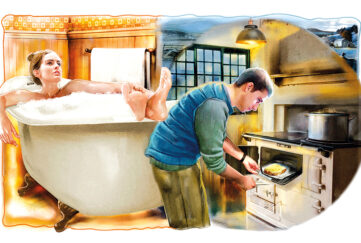There’s Always Tomorrow – Episode 22

There's Always Tomorrow by Mark Neilson
« Previous Post- 19. There’s Always Tomorrow – Episode 19
- 20. There’s Always Tomorrow – Episode 20
- 21. There’s Always Tomorrow – Episode 21
- 22. There’s Always Tomorrow – Episode 22
- 23. There’s Always Tomorrow – Episode 23
- 24. There’s Always Tomorrow – Episode 24
- 25. There’s Always Tomorrow – Episode 25
A sudden pang of jealousy flashed through Helen.
“Oh,” she said, swinging round a pothole in the narrow road.
“She died over sixty years ago,” Larry continued, oblivious. “One of Scotland’s great forgotten artists.”
“Oh,” Helen said again, furious with herself. “What sort of work did she do?”
Larry rubbed his chin.
“Her work was paintings of slum children in Glasgow.
“The paintings aren’t pretty – shapeless kids with dirty faces in ragged clothes.
“They were strong sketches, often against primary colours. They were my first real lesson in painting.”
“That doesn’t sound like your kind of thing,” Helen remarked, turning on to the main road.
“They’re not,” Larry replied. “But their message was important to me.
“Most people expect artists to paint like a camera. To produce in exact detail an image of what they’re seeing. Not always.
“Some artists show what emotions the subject sparks in them. In her street children, Joan Eardley was painting kids without a future.
“She used harsh shapes, empty faces and eyes that were featureless blobs, because the owners had nothing to look forward to but poverty.
Larry paused.
“Am I boring you?”
“No. I never realised that an artist could be more interested in communicating feelings than producing a likeness,” Helen confessed.
“That’s the whole essence of Joan Eardley’s work,” Larry explained.
The road they took down to the sea rapidly became one of the narrowest roads she had ever driven.
It seemed quite empty of traffic, and Helen prayed that it would remain so.
“Stop here,” Larry stated. “In this lay-by. I want us to walk this final stretch of road to get the feel of the place.”
They walked down a steep bend that led from the scatter of cottages on the cliff top to the tiny rough harbour amid raw reefs of rock stretching into the sea.
Above them, seabirds soared and called as the rest of the world disappeared.
“What do you sense?” Larry asked.
Helen paused.
“Light,” she said finally. “It’s all around us – from the sky and reflected by the sea. It makes the countryside above us almost shimmer.”
“Bravo,” Larry replied quietly. “The light is special. It makes the colours vibrant and dramatic.
“See the field sloping down above us from that cottage? She painted that scene at harvest time, and its bleached yellow barley crop comes alive and cascades out of her painting towards you.
“When you stand here in late summer and a wind is blowing, flattening the barley in waves towards you, it looks like a broad river sweeping down.
“It was that movement she was trying to capture in her harvest paintings.”
Larry gestured back at the cottages.
“She painted from behind these cottages above us, looking down to the sea. She made the sea and the sky fuse into whirls of light.
“If you ever try to paint the sun, its dazzle plays tricks with your vision. It makes light swim around it, almost in whirlpools.
“That’s what she was trying to show: light itself is a living, moving thing.”
Larry looked at her.
“Are you sure this isn’t boring you?”
“Not yet,” Helen teased.
Not even close, she thought. His intensity and passion for the subject was drawing her in – like painting the sun might do.
Helen sensed that Larry had opened up, letting her glimpse not just his love of art, but his soul.
In trying to explain what the place and the paintings meant to him, he was letting her in behind his defences.
She struggled to follow what he was saying, because she sensed that this was key to understanding the man himself.
Suddenly it was important for her to see behind the damaged but still-tough Army sergeant to the person underneath.
“How did you discover her work?” Helen asked.
Larry turned to her, taking his eyes off the sea and its changing colours.
“Would you believe it was an Army chaplain?” He smiled. “I was always staring at the sky.
“The chaplain said to me, ‘If the sky means so much to you, then you must see Joan Eardley’s skies. There are times when I look at her paintings and see God’.”
“Wow!” Helen exclaimed.
Standing at the edge of the harbour, with the cliffs towering over her and ragged ridges of rocks carving into a sea which stretched out before her, she felt very small.
She shuddered. It was a scary feeling.
“So how did you manage to find her work?” Helen asked.
Larry sighed.
“I looked online and what I found blew me away. She saw more in the sky than I had ever done.
“Thick swirls of light, making the sea come alive; thunderous clouds above waves crashing in on this shore. The raw savagery of the storm was reflected in the power of her paintings.”
Larry smiled.
“She taught at the Glasgow School of Art, and the locals here used to phone to tell her when a big storm was brewing,” he continued.
“She left her students to catch the first train north.
“She wedged herself and her easel between rocks. She had to tie her easel down sometimes, as the wind battered in on both of them.




